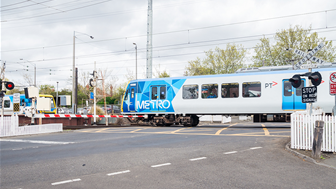Melbourne company Leash IT has begun marketing a Bluetooth Low Energy (BLE) bracelet to help with social distancing and contact tracing in workplaces and public facilities.
The company is pitching the LeashView Social Distancing Bracelet as a tool to help businesses, medical centres, sporting venues, schools, warehouses, shopping centres, concert halls and other facilities to comply with COVID-19 rules. The bracelets and other types of BLE wearables are being used in a number of Australian medical facilities, hospitals and labs. A major construction and mining company are also beginning to pilot the bracelets.
Leash IT founder and CEO Tony Lotzof touts the versatility of the bracelet. “A sporting organisation could offer these to supporters as part of their membership, and the one bracelet can be used in multiple venues by the wearer,” he stated.
The bracelet vibrates and flashes a red LED light when within two metres of another LeashView bracelet. It collects the MAC address of the other bracelet and the date and time of the close contact, and each day it uploads those details to a phone app which then uploads it to LeashView software. An organisation can then use this information to create a contact tracing report, with the system alerting close contacts via the phone app.
The company is pointing to the bracelet’s ability to function without Bluetooth gateways and without recording location data as selling points (though Leash IT also sells a different version of the bracelet that can be used with additional hardware to track a user’s location). It also promotes the product’s ability to work outdoors, such as at road works and mining sites.
Leash IT has also announced the integrated LeashView Access Control Camera. The two megapixel camera uses AI to recognise faces, staff members’ ID numbers, and whether they are wearing masks, and checks for elevated body temperature.
The camera can be used with a desk mount or floor stand. It also has a traffic light stand that shows green when a verified user is identified and when set rule anomalies are not detected. A red light indicates that selected pass criteria do not meet the business’s OH&S rules.
Location-based contact tracing
As mentioned earlier, Leash IT also sells a version of the bracelet that records location information, using LeashView software and BLE gateways installed throughout a premises. It also markets the use of wearable BLE tags with gateways and LeashView for location-based contact tracing in workplaces.
The BLE tags transmit every 10 seconds to the gateways. The gateways report the room location and ID of nearby tags, and those details are overlayed on a map by the LeashView software.
“Knowing where they are, where they have been and who else they have been in close contact with enables them to take immediate action in the event of a suspected COVID-19 infection, and minimise the disruption to their business,” Lotzof stated.
The software can alert an organisation when room occupancy levels exceed thresholds. Leash IT also promotes the use of LeashView to track whether cleaners have adhered to cleaning schedules and to set rules limiting access to areas. Its system also has man down and duress functionality.
Leash IT also sees shopping centres as potential users. The company envisages shopping centre staff members wearing the BLE tags and customer loyalty cards containing the tags. Customers would download a shopping centre’s mobile app to get LeashView functions on their phone, according to Leash IT. LeashView could be used to send reminders to shopping centre employees and customers to sanitise their hands, the company states. Reminders could arrive every hour, or after people have visited more than two shops, for example.
The software could also be used to manage how many people are allowed into a shop at the same time. And it could be used for contact tracing and determining where to clean after an infected person has visited a shopping centre. Administrators could also use the system to verify how many staff members and visitors are in a shopping centre at any moment and during the entire day. And they could use it to determine where the most foot traffic occurs so they can adjust the daily cleaning regime accordingly.
Leash IT is a sponsor of this COVID-19 discussion hub.
Focus is increasing on use of real-time data to combat the COVID-19 pandemic. See our special coverage about key issues.







